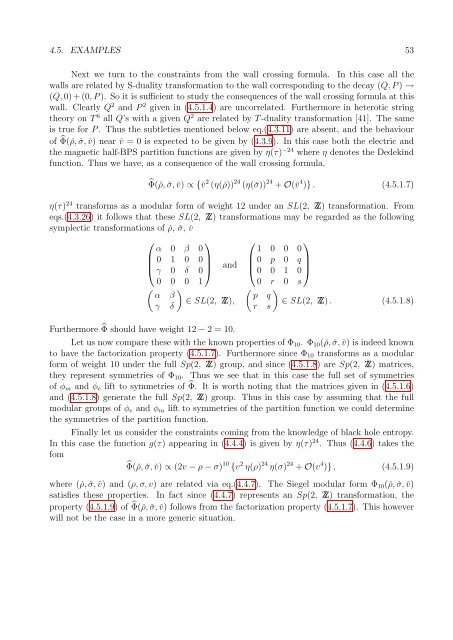PHYS08200604018 Shamik Banerjee - Homi Bhabha National ...
PHYS08200604018 Shamik Banerjee - Homi Bhabha National ...
PHYS08200604018 Shamik Banerjee - Homi Bhabha National ...
Create successful ePaper yourself
Turn your PDF publications into a flip-book with our unique Google optimized e-Paper software.
4.5. EXAMPLES 53<br />
Next we turn to the constraints from the wall crossing formula. In this case all the<br />
walls are related by S-duality transformation to the wall corresponding to the decay (Q, P ) →<br />
(Q, 0) + (0, P ). So it is sufficient to study the consequences of the wall crossing formula at this<br />
wall. Clearly Q 2 and P 2 given in (4.5.1.4) are uncorrelated. Furthermore in heterotic string<br />
theory on T 6 all Q’s with a given Q 2 are related by T -duality transformation [41]. The same<br />
is true for P . Thus the subtleties mentioned below eq.(4.3.11) are absent, and the behaviour<br />
of ̂Φ(ˇρ, ˇσ, ˇv) near ˇv = 0 is expected to be given by (4.3.9). In this case both the electric and<br />
the magnetic half-BPS partition functions are given by η(τ) −24 where η denotes the Dedekind<br />
function. Thus we have, as a consequence of the wall crossing formula,<br />
̂Φ(ˇρ, ˇσ, ˇv) ∝ {ˇv 2 (η(ˇρ)) 24 (η(ˇσ)) 24 + O(ˇv 4 )} . (4.5.1.7)<br />
η(τ) 24 transforms as a modular form of weight 12 under an SL(2, Z) transformation. From<br />
eqs.(4.3.26) it follows that these SL(2, Z) transformations may be regarded as the following<br />
symplectic transformations of ˇρ, ˇσ, ˇv<br />
Furthermore ̂Φ should have weight 12 − 2 = 10.<br />
⎛<br />
⎞ ⎛<br />
⎞<br />
α 0 β 0<br />
1 0 0 0<br />
⎜ 0 1 0 0<br />
⎟<br />
⎝ γ 0 δ 0 ⎠ and ⎜ 0 p 0 q<br />
⎟<br />
⎝ 0 0 1 0 ⎠<br />
0 0 0 1<br />
0 r 0 s<br />
( )<br />
( )<br />
α β<br />
p q<br />
∈ SL(2, Z),<br />
∈ SL(2, Z) . (4.5.1.8)<br />
γ δ<br />
r s<br />
Let us now compare these with the known properties of Φ 10 . Φ 10 (ˇρ, ˇσ, ˇv) is indeed known<br />
to have the factorization property (4.5.1.7). Furthermore since Φ 10 transforms as a modular<br />
form of weight 10 under the full Sp(2, Z) group, and since (4.5.1.8) are Sp(2, Z) matrices,<br />
they represent symmetries of Φ 10 . Thus we see that in this case the full set of symmetries<br />
of φ m and φ e lift to symmetries of ̂Φ. It is worth noting that the matrices given in (4.5.1.6)<br />
and (4.5.1.8) generate the full Sp(2, Z) group. Thus in this case by assuming that the full<br />
modular groups of φ e and φ m lift to symmetries of the partition function we could determine<br />
the symmetries of the partition function.<br />
Finally let us consider the constraints coming from the knowledge of black hole entropy.<br />
In this case the function g(τ) appearing in (4.4.4) is given by η(τ) 24 . Thus (4.4.6) takes the<br />
fom<br />
̂Φ(ˇρ, ˇσ, ˇv) ∝ (2v − ρ − σ) 10 {v 2 η(ρ) 24 η(σ) 24 + O(v 4 )} , (4.5.1.9)<br />
where (ˇρ, ˇσ, ˇv) and (ρ, σ, v) are related via eq.(4.4.7). The Siegel modular form Φ 10 (ˇρ, ˇσ, ˇv)<br />
satisfies these properties. In fact since (4.4.7) represents an Sp(2, Z) transformation, the<br />
property (4.5.1.9) of ̂Φ(ˇρ, ˇσ, ˇv) follows from the factorization property (4.5.1.7). This however<br />
will not be the case in a more generic situation.

















